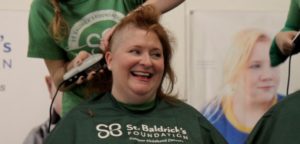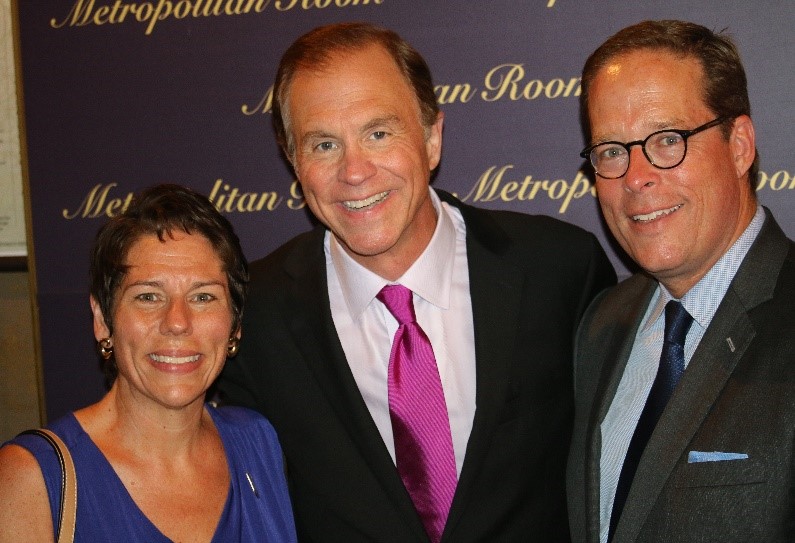


When Roger Schmelzer belts out a favorite tune at one of the top cabaret venues in the country, he’s not just doing it for pleasure. He’s singing his heart out for kids with cancer and to support the St. Baldrick’s Foundation, a not-for-profit organization dedicated to funding childhood cancer research.
“When I was 13 years old my mother died of cancer,” Schmelzer recalled. “It was frightening to watch her so sick and to have a lot of unanswered questions, so I can’t imagine what these children who are fighting the disease must be going through.”
Schmelzer is not only a gifted crooner, he is also president of the National Conference of Insurance Guaranty Funds (NCIGF), a non-profit member funded association that provides national assistance and support to property/casualty guaranty funds. “Assistance and support is part of NCIGF’s core mission, so it’s only natural that it includes a philanthropic commitment to an organization like St. Baldrick’s,” he said.
St. Baldrick’s came into Schmelzer’s life through a friend and former colleague of his, Chuck Chamness, whose son Joey was in treatment for osteosarcoma, a malignant tumor of the bone, which had occurred in Joey’s leg. “Watching the courage that family had was an inspiration to me,” said Schmelzer. “Chuck had been CEO for less than two years in 2005 when Joey was diagnosed. It was a rough time.”
“We broke the news to the family, set the treatment—chemo, surgery,” said Chamness. “Two weeks later I picked up one of the trade publications and saw a piece about the publisher shaving his head for this new foundation St. Baldrick’s. It couldn’t have been more perfect as this issue had become the most important part of our lives.”

Since Joey’s bout with cancer, each member of the Chamness family has been active participants in their hometown of Indianapolis, Ind. Joey’s Mom, Briget, and his siblings, Charlie, Sally and Robbie, have joined him and his Dad as shavees. But it didn’t end there for Chamness. In the summer of 2013 he accepted the role of chairman of the St. Baldrick’s Foundation’s board of directors; the first time a cancer parent led the organization.
“St. Baldrick’s is about the kids, their families, the research we support and all the volunteers who make it possible,” Chamness said. “We are committed to helping kids with cancer survive and lead the long and healthy lives we wish for them.”
In his professional life, Chamness is the president and chief executive officer of the Indianapolis-based National Association of Mutual Insurance Companies (NAMIC), a P/C insurance trade association representing 1,400-member companies and 40 percent of the industry by premium. NAMIC members and staff have embraced the cause and St Baldrick’s, raising more than $450,000 in the past year.
It’s no surprise Chamness or Schmelzer are a part of this cause since the idea for St. Baldrick’s came from the insurance industry. In fact, it is still supported by the industry. Since St. Baldrick’s started nearly 20 years ago, the insurance industry has accounted for $18.2 million, both donated and fundraised. This number includes $11.5 million that was raised through 135 hosted head-shaving events, where more than 2,600 people shaved their heads.
Early Beginnings
Each summer, for as long as they could remember, friends from the reinsurance industry got together over the Fourth of July holiday to play a round of golf followed by a backyard barbecue. But 1999 was different. All three—John Bender of Allied World Re, Tim Kenny of QBE the Americas (then, now co-founder and CEO of Aran Insurance) and Enda McDonnell of Access Re talked well into the night. Around 2:00 a.m. the talk turned serious. Kenny said to the other two, “What are you most grateful for?” Each of the men said that their lives were going well. Kenny then asked, “so when are you going to start giving back?”
Each of them knew a child with cancer. The kids were undergoing chemotherapy and it was making their hair fall out. “I said to McDonnell, who sported long, blonde hair at the time. ‘Why don’t you show your solidarity with these kids by shaving your head?'” Bender recalled. “McDonnell shot back: ‘Why don’t you?'”
As it turned out, they all would.
These colleagues turned their industry’s annual St. Patrick’s Day party at Jim Brady’s, an Irish bar in lower Manhattan, into a fundraiser that would benefit kids with cancer. The goal of shaving 17 heads and raising $17,000 ended with 19 bald heads and $104,000 donated to fund the research of the Children’s Oncology Group (COG), a National Cancer Institute supported clinical trials group.
Making a Difference
Since becoming an independent Foundation in 2005, St. Baldrick’s has turned into the largest private funder of childhood cancer research grants in the world holding nearly 1,300 events a year; funding research in 29 countries with anywhere from 55,000 to 65,000 shavees annually. They have cumulatively awarded 1,282 grants, totaling more than $234 million.
“When you have incredible leaders like Chuck, they make an impact,” said Kathleen Ruddy, chief executive officer of St. Baldrick’s Foundation. Ruddy has been with St. Baldrick’s since 2001, becoming executive director in 2004. The daughter of two cancer survivors, Ruddy believes in paying it forward, and enjoys managing the Foundation, in addition to being a two-time shavee, a Do What You Want St. Baldrick’s fundraiser (raising funds through activities other than head-shaving) and active advocate for children with cancer.
“In the early years of the Foundation, the reinsurance industry and then the wider insurance industry became involved. They have remained the backbone of our corporate sponsorship over the years,” Ruddy said, adding, “I’ve never seen an industry in all my years in fundraising, adopt a cause like this. There are not that many causes that an entire industry would rally around.”
St. Baldrick’s utilizes its head-shaving program as a way to raise critical funds for childhood cancer research. “We’re looking to conquer childhood cancers. Shaving heads is one way we do this. The researchers need to be in the labs and the hospitals, saving patients. But they can’t do that unless they have the funding. What we’re doing is enabling these researchers to save lives.”

“Our grant applications are reviewed by a group of more than 180 pediatric oncology experts in a rigorous peer-review process We take every dollar and every grant decision seriously because kids’ lives are at stake,” said Ruddy. “The scientists apply their expertise and recommend which grants to support, and this ensures donations support the strongest research projects—wherever they are, thus ensuring more kids benefit from the research.”
Ruddy noted that there are more than 100 child cancers. The average age that a child gets cancer is six years old. “If you are diagnosed at six, but you relapse in your teens and pass away, you are still counted as a survivor because you reached that five-year cancer-free milestone. If you’re fortunate to survive, there are so many late affects. Some face stunted growth, loss of limbs and organs, vision or hearing. Others live with brain damage caused by radiation. In these cases, your ‘cure’ still doesn’t look like success. Others face second and third cancers caused by the original treatment or infertility issues. Yes, treatment extended their life, but it’s a compromised future.”
Ruddy is passionate about the cause and the work St. Baldrick’s has done. “When St. Baldrick’s started, researchers needed a new weapon to combat childhood cancers as they had gone as far as possible with the traditional combination of chemotherapy, surgery and radiation. This is why the new frontier of immunotherapy—harnessing the power of the body’s immune system to fight cancer—is so encouraging.”
“In the last 20 years, only four new therapies have been approved for kids with cancer in the U.S., two from repurposing adult drugs, and two developed uniquely for kids’ special needs. As a comparison, there are more than 900 therapies in the pipeline right now for adult cancers. They won’t all be approved, but this highlights the difference in the scale of effort aligned behind adult patients compared to children.”
Ruddy is particularly proud of the St. Baldrick’s funding that has made some of today’s breakthroughs in childhood cancer research possible, such as Kymriah, the first-ever FDA-approved gene therapy for use in children with acute lymphoblastic leukemia. “The kids who are receiving it were, prior to Kymriah, out of treatment options. Today, 83 percent of those kids who have received Kymriah have no evidence of the disease.”
Ruddy noted that St. Baldrick’s helped advance the Childhood Cancer STAR Act, which was recently signed into law. This groundbreaking legislation authorizes $30 million annually from 2019 to 2023 for programs and research related directly to childhood cancer. “This is the most comprehensive childhood cancer bill ever signed into law; prioritizing childhood cancer research at the National Institutes of Health (NIH) and improving targeted treatments, surveillance and quality-of-life resources for survivors.”
“Joey is a survivor,” said Chamness. He’s doing well. He’s a senior in college majoring in business and has an internship this summer in finance. We’re very grateful for the success he’s had; the health that he’s had, especially when many of the kids we knew in treatment didn’t survive. But the long-term risks related to the treatment and the disease are real. We can’t help thinking about that. But still we’re grateful because we’ve known many families with devastating outcomes.”
Chamness has learned to live in the moment. “The occurrence of a life-threatening disease in an innocent eight-year-old challenges you in a lot of ways and changes you long-term,” he said. “Back on Day 1 when we returned home from the diagnosis, we had a family meeting with the other three kids. The first question our daughter Sally asked us was whether Joey would lose all his hair. That was her primary concern. At that age you’re not capable of processing that your brother could lose his life.
“By design, ‘going bald’ is the signature of St. Baldrick’s for the empathy that is shown for kids that lose their hair. As the Foundation has matured, we have created a ‘Do What You Want’ fundraising platform for people to host their own creative fundraisers to support the cause. Not everybody is ready to shave their head. But the money raised all goes for the same important cause.

“Over the years, people in the industry have been raising money in creative ways, from mountain climbing, to biking across the state, across the country, even to singing,” Chamness said.
“Roger has been a longtime friend since we worked together in Washington. And he was like so many others who reached out immediately when we got the diagnosis. That he’s found this event, helped raise money, it’s a labor of love. These venues showcase his immense talent so well and that he’s dedicated it to St. Baldrick’s is extra nice. It shows who Roger is.
“His singing gift? I’d pay to hear him, and I do,” Chamness said.
Roger will perform his HeartSongs to benefit St. Baldrick’s on Thursday July 19, 2018, 7:00 pm at “Don’t Tell Mama’s,” 343 W 46th Street, (Between 8th and 9th). For reservations go to https://donttellmamanyc.com/shows/main/4674-roger-schmelzer-heartsongs or to donate go to https://www.stbaldricks.org/fundraisers/HeartSongs2018